Businesses in the transportation and storage sector
Data extracted in February 2024
Planned article update: March 2025
Highlights
The transportation and storage services' value added exceeded the pre-pandemic years and accounted for €527.5 billion in 2021.
This article presents an overview of statistics for the European Union's (EU) transportation and storage services sector, as covered by NACE Rev. 2 Section H. It belongs to a set of statistical articles on 'Business economy by sector'.
The transportation and storage services sector focuses on transport services provided to clients for hire and reward. When analysing transport traffic volumes (for example, tonnes of freight) it is important to bear in mind that these include own account transport as well as transport services for hire and reward. This is particularly important in road transport where, for example, a manufacturer might collect materials or deliver own output, rather than contracting a transport service enterprise to do this and equally, the use of own vehicles (typically passenger cars) accounts for a very large part of passenger transport. Such own account transport does not contribute towards the statistics on the transportation and storage services sector.
Full article
Structural profile
In 2021, the transportation and storage services sector recovered from the COVID-19 pandemic which had caused the disruption of the business environment, including the temporary shutdown of some business sectors, many of those in the transportation field, for example the air transport subsector (Division 51). In 2021, the value added increased by 21.6 % compared with 2020 and exceeded the COVID-19 pre-pandemic levels, being 3.4 % higher than in 2019. In 2021, the value added of the sector accounted for €527.5 billion, representing 5.6 % of the wealth generated in the business economy.
A similar effect can be seen in the number of enterprises in the EU's transportation and storage services sector. In 2021, there were almost 1.4 million enterprises in this sector, equivalent to 4.5 % of the business economy (Sections B to N and P to R, as well as Divisions S95 and S96) enterprise population. This represents an increase of 7.9 % compared with 2020. The transportation and storage services sector employed 10.2 million persons in 2021, which represented 6.5 % of those working in the business economy. The number of persons employed in transportation and storage services sector decreased by 0.9 % compared with 2020 and by 2.6 % compared with the COVID-19 pre-pandemic times.
The relatively low share of transportation and storage services in the business economy enterprise population indicates that the average size of enterprises in the transportation and storage services sector (in value added or employment terms) was above average. Indeed, this sector includes some activities which are dominated by very large enterprises, for example, postal services, air and rail transport services.

Source: Eurostat (sbs_ovw_act)
Several indicators based on labour input show the transportation and storage services sector to be quite typical, when compared with the business economy as a whole. The apparent labour productivity of the EU's transportation and storage services sector in 2021 was €51 800 per person employed, quite close to the business economy average (€60 200 per person employed). Average employee benefits expense (average personnel costs) were €35 800 per employee, which is also quite close to the business economy average (€39 000 per employee). The combination of these two indicators produces a wage-adjusted labour productivity ratio of 144.8 % for the transportation and storage services sector, slightly lower than the business economy average of 154.4 %.
By contrast, the gross operating rate (the relation between the gross operating surplus and turnover) for the EU's transportation and storage services sector was 13.4 % in 2021, which was close to the business economy average (13.2 %).
Sectoral analysis
In value added terms, the largest subsector (at the division level) in the EU's transportation and storage services sector was that of land transport and transport via pipelines (Division 49), which accounted for more than two-fifths (42.9 %) of sectoral value added in 2021, followed by warehousing and support activities for transportation (Division 52 - 32.2 %)) and postal and courier activities (Division 53 – 10.9 %), while air transport (Division 51) was the smallest subsector among the available ones with a share of 3.4 %.

(% share of sectoral total)
Source: Eurostat (sbs_ovw_act)
The land transport and transport via pipelines subsector had a notably larger share of employment (than value added), as it employed more than half (55.6 %) of the EU's transportation and storage services sector's employment in 2021, while the warehousing and support activities for transportation and the postal and courier activities accounted for a share of the sectoral employment of 23.6 % and 16.0 % respectively. The water transport sector accounted for the smallest share of the transportation and storage services sector's employment (1.8 %).

Source: Eurostat (sbs_ovw_act)
Consequently, the subsectors recorded quite different levels of average employee benefits expense in 2021. Among the available data, the air transport subsector recorded the highest average employee benefits expense with €60 000 per employee, considerably higher than the average for the transportation and storage sector (€35 800 per person employed) and business economy average (€39 000 per person employed).
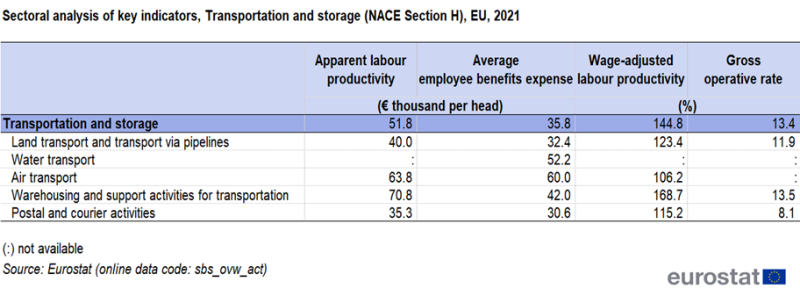
Source: Eurostat (sbs_ovw_act)
Substantially lower average employee benefits expense was also recorded for postal and courier activities (€30 600 per employee) and for land transport and transport via pipelines (€32 400 per employee), and as such both of these subsectors had average employee benefits expense that were below the business economy average.
The EU's warehousing and support activities for the transportation subsector recorded the highest wage-adjusted labour productivity in 2021 among the available data, with apparent labour productivity equivalent to 168.7 % of average employee benefits expense.
Country overview
Germany had the highest levels of value added among the EU Member States in three out of the five transportation and storage services subsectors. France's share of EU added value peaked for land transport and transport via pipelines with a share of 8.5 %, while Denmark's share of EU added value peaked in the water transport subsector at 3.1 %. The Baltic Member States and Denmark were particularly specialised in the transportation and storage services sector in value added terms, as Lithuania (13.5 %), Denmark (12.9 %) and Latvia (8.0 %) generated far greater shares of their business economy value added in this sector in 2021 than any other EU Member State. Lithuania was primarily specialised in land transport and transport via pipelines subsector (10.0 % of business economy value added). Denmark reported the highest degrees of specialisation in the water transport subsector (8.6 %), Malta in the air transport subsector (2.1 %), Cyprus in the warehousing and support activities for transportation (3.9 %), while Germany was the most specialised EU Member State in the postal and courier activities, with 0.8 % of its business economy value added coming from this subsector.

Source: Eurostat (sbs_ovw_act)
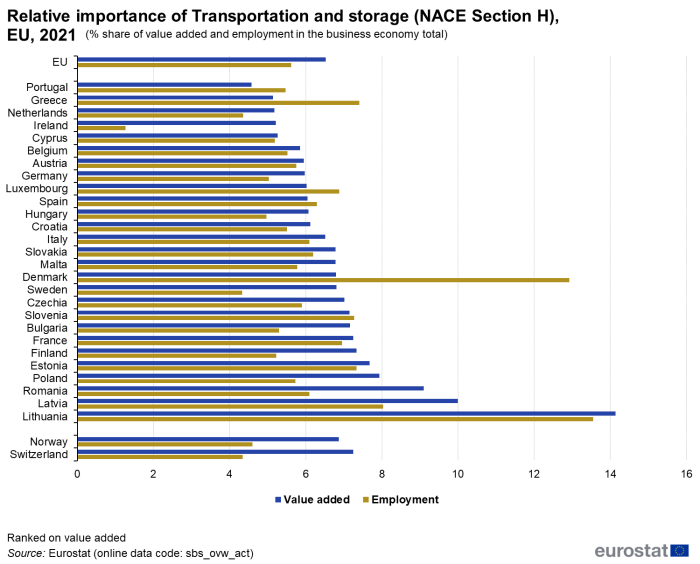
(% share of value added and employment in the business economy total)
Source: Eurostat (sbs_ovw_act)
Thanks to its geographical position in the center of Europe, Germany recorded the highest levels among the Member States in both value added (26.2 %) and employment (22.5 %). It was followed by France (17.9 % value added; 14.0 % employment) and Italy (11.4 % value added; 11.3 % employment).
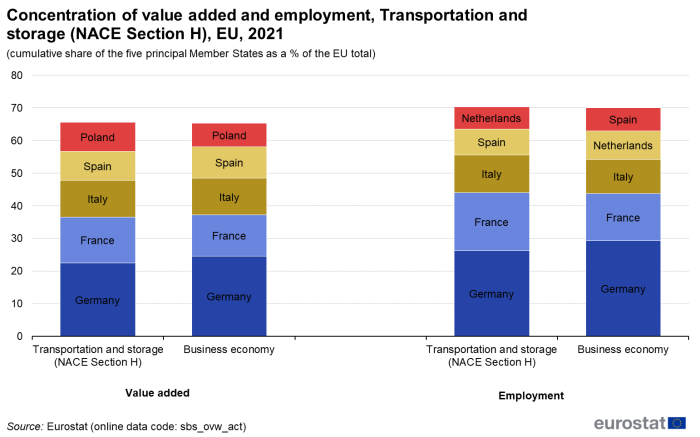
(cumulative share of the five principal Member States as a % of the EU total)
Source: Eurostat (sbs_ovw_act)
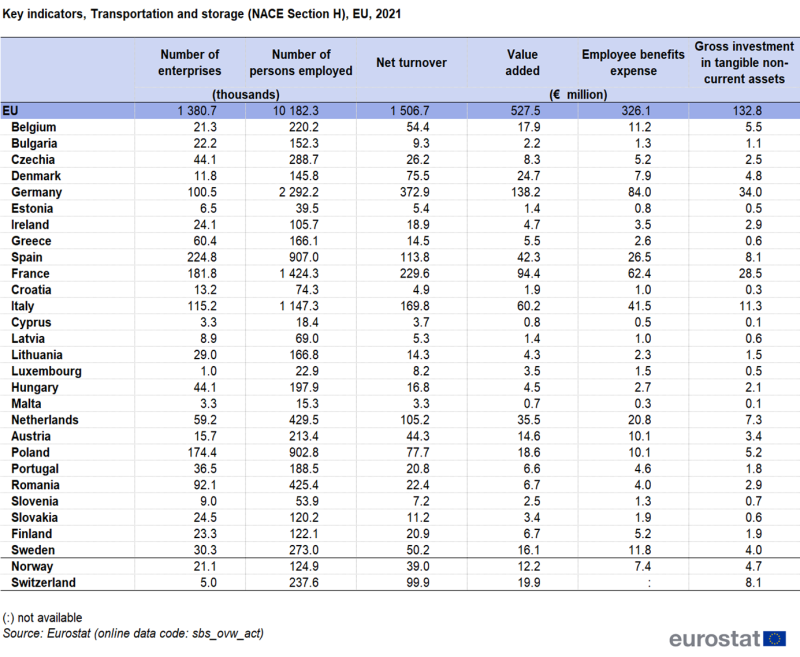
Source: Eurostat (sbs_ovw_act)
A large majority of EU Member States had a higher wage-adjusted labour productivity ratio for the transportation and storage services sector than the non-financial economy average (154.4 %). Denmark recorded the highest ratio with 300.5 %. At the other end of the scale, Ireland recorded a wage-adjusted labour productivity ratio of 110.5 % for transportation and storage services.
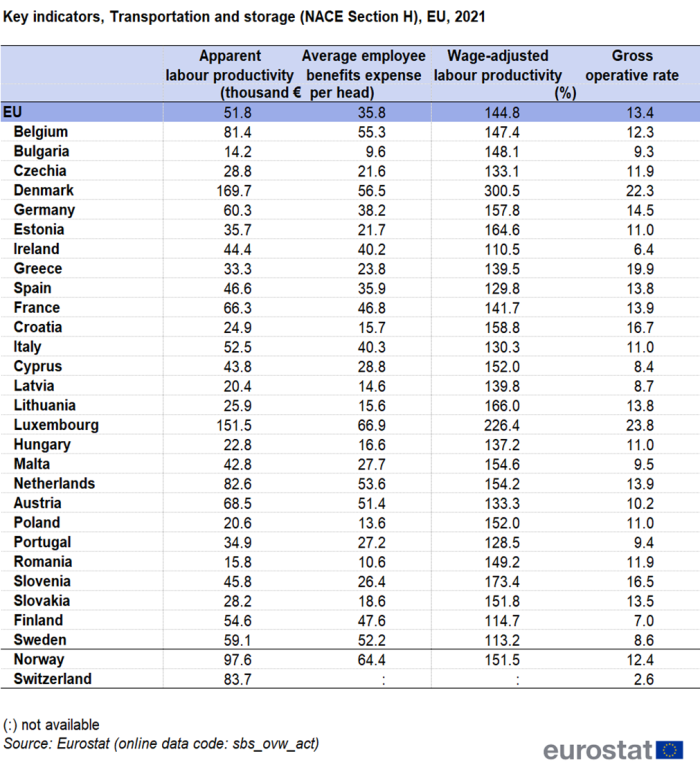
Source: Eurostat (sbs_ovw_act)
Data sources
Coverage
Transportation services concern passenger and freight transport, whether scheduled or not, regardless of the transport mode, and also include postal and courier services. Furthermore, the transportation and storage services sector covers warehousing and storage, alongside transport support activities such as terminal and parking facilities (bus and train stations, harbours, airfields, car parks), infrastructure operations (such as rail networks, waterway locks, roads, bridges, tunnels, air traffic control), support services (towing, shunting, berthing, pilotage), cargo handling and freight forwarding.
The sector is mainly structured according to the different modes of transport, and contains five different NACE divisions, as follows:
- land transport by rail, road and pipeline (Division 49);
- sea and coastal water transport and inland water transport of freight and passengers (Division 50);
- passenger air transport, as well as freight air transport and space transport (Division 51);
- warehousing and support activities for transportation (Division 52);
- postal and courier activities (Division 53).
The transportation and storage services sector does not include the major repair or alteration of transport equipment which is part of repair activities within the manufacturing sector (Section C), nor the construction, maintenance and repair of transport networks (such as roads and railways) or terminals (such as harbours and airfields) which are part of the construction sector (Section F). Travel agencies and tour operators are also excluded as these are covered within administrative and support service activities (Section M). Training in the operation of transport equipment is considered as an education activity, while the operation of marinas is considered part of sports activities and amusement and recreation activities (note that both of these activities lie outside the delineation of the business economy and are traditionally not covered by structural business statistics).
Data sources
The analysis presented in this article is based on the main dataset for structural business statistics (SBS), size class data and regional data, all of which are published annually.
The main series provides information for each EU Member State as well as a number of non-EU member countries at a detailed level according to the activity classification NACE. Data are available for a wide range of variables. Structural business statistics cover the 'business economy', which includes industry, construction and many services (NACE Rev. 2 sections B to N, P to R as well as division S95 and S96). Structural business statistics do not cover agriculture, forestry and fishing, nor public administration. Structural business statistics describe the business economy through the observation of units engaged in an economic activity; the unit in structural business statistics is generally the enterprise. An enterprise carries out one or more activities, at one or more locations, and it may comprise one or more legal units. Enterprises that are active in more than one economic activity (plus the value added and turnover they generate, the people they employ, and so on) are classified under the NACE heading corresponding to their principal activity; this is normally the one which generates the largest amount of value added.
In structural business statistics, size classes are generally defined by the number of persons employed. A limited set of the standard structural business statistics variables (for example, the number of enterprises, turnover, persons employed and value added) are analysed by size class, mostly down to the three-digit (group) level of NACE. The main size classes used in this article for presenting the results are:
- small and medium-sized enterprises (SMEs): with 1 to 249 persons employed, further divided into:
- micro enterprises: with less than 10 persons employed;
- small enterprises: with 10 to 49 persons employed;
- medium-sized enterprises: with 50 to 249 persons employed;
- large enterprises: with 250 or more persons employed.
Structural business statistics also include regional data. Regional SBS data are available at NUTS levels 1 and 2 for the EU Member States, Iceland and Norway, mostly down to the two-digit (division) level of NACE. The main variable analysed in this article is the number of persons employed. The type of statistical unit used for regional SBS data is normally the local unit, which is an enterprise or part of an enterprise situated in a geographically identified place. Local units are classified into sectors (by NACE) normally according to their own main activity, but in some EU Member States the activity code is assigned on the basis of the principal activity of the enterprise to which the local unit belongs. The main SBS data series are presented at national level only and for this national data the statistical unit is the enterprise. It is possible for the principal activity of a local unit to differ from that of the enterprise to which it belongs. Hence, national SBS data from the main series are not necessarily directly comparable with national aggregates compiled from regional SBS.
Context
EU transport policies aim to foster clean, safe and efficient travel throughout Europe, underpinning the internal market for goods and the right of citizens to travel freely throughout the EU. This policy is based upon a 2011 White paper — Roadmap to a Single European Transport Area — Towards a competitive and resource efficient transport system, which included 40 specific initiatives to build a competitive transport system and aims to increase mobility, remove major barriers in key areas, and fuel growth and employment. At the same time, the proposals endeavour to dramatically reduce the EU's dependence on imported oil and cut carbon emissions in transport by 60 % by 2050. Key goals to be achieved by 2050 include: no more conventionally-fuelled cars in cities; 40 % use of sustainable low carbon fuels in aviation; at least a 40 % cut in shipping emissions; a 50 % shift of medium distance intercity passenger and freight journeys from road to rail and/or waterborne transport.
In most EU Member States, universal service providers still operate as a monopoly and have exclusive rights within the postal market, balanced by the fact that they have a universal service obligation. Indeed, postal services are of vital importance for commercial users and households alike and are considered as a service of general economic interest. Private operators dominate the express services market, providing letter and parcel services, specifically to the business-to-business, direct mail and business-to-private segments of the market. Since the middle of the 1990s there have been gradual developments towards market liberalisation for postal and courier services, with parcels and express services markets now fully open to competing operators. The latest amendment (2008/6) of the European Parliament and of the Council to the 1997 Directive on Community postal services was adopted in February 2008 and set out a timetable to abolish restrictions that remain for mail deliveries under 50 grams (known as the 'reserved area' for national operators) and open up the EU's postal services market to full competition. The deadline for full market opening was the end of 2010 for 16 of the EU Member States (which represent 95 % of the internal postal market), with a transitional period until the end of 2012 for the remainder. In 2010, there was a European Commission Decision taken establishing the European Regulators Group for Postal Services, its role is to:
- advise and assist the Commission in consolidating the internal market for postal services;
- advise and assist the Commission on any matter related to postal services within its competence;
- advise and assist the Commission as to the development of the internal market for postal services and as to the consistent application in all EU Member States of the regulatory framework for postal services;
- consult, in agreement with the Commission, extensively and at an early stage of its expert work with market participants, consumers and end-users in an open and transparent manner.
Direct access to
- Other analyses of the business economy by NACE Rev. 2 sections
- Structural business statistics introduced
- Structural business statistics – overview article
- Structural business statistics at regional level
More detailed analysis of transportation and storage activities:
- Recent Eurostat publications on SBS
- Key figures on Europe – 2023 edition – see subchapter on Business
- Eurostat's Regional Yearbook – see chapter 8. Business
- News Release SBS – 2021 final data
Glossary
ESMS metadata files
- Structural business statistics – SBS metadata file